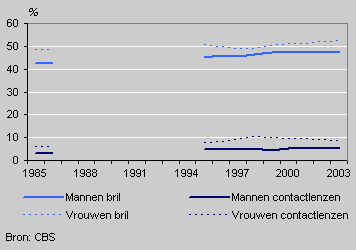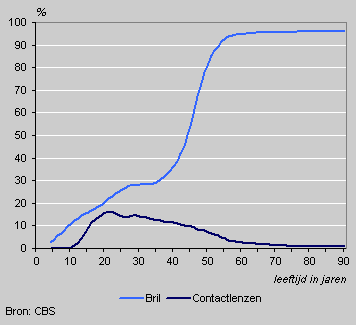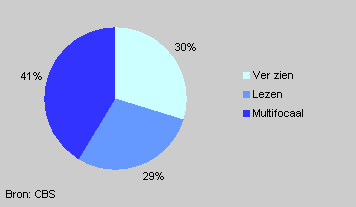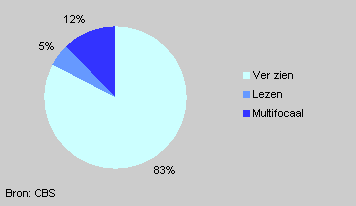Glasses: inevitable in the long run

In 2003 nearly 9 million people in the Netherlands wore glasses or contact lenses. Nearly everybody over the age of 55 wears glasses. Contact lenses are popular with people aged between 15 and 45.
Over half the population has glasses or contact lenses
Since 1985 the use of glasses or contact lenses has risen from 50 percent to 57 percent in 2003. The use of contact lenses grew from 4 percent in 1985 to 7 percent in the late 1990s and has been stable for years. More women than men wear glasses and women also wear contact lenses twice as often as men.
Glasses and contact lenses by sex

Contact lenses popular among young people
The use of glasses or contact lenses increases with age. One in ten 10-year-olds wear glasses, around the age of 30 it is four in ten. From the age of 40 the use of visual aids increases dramatically and people in the Netherlands around 55, almost without exception, wear glasses or contact lenses.
Contact lenses are most popular with young people between 20 and 25. Few over-60s wear contact lenses. Well-educated people more often wear contact lenses. Thus 13 percent of people graduated from vocational colleges wear contact lenses as opposed to only 3 percent of people whose highest level of education is primary school.
Titel???

Older people often wear bifocals
Three out of every four persons under 40 wear glasses because of short-sightedness. Eight out of every ten people wearing contact lenses do so to see objects more clearly in the distance. Reading problems start from the age of 40. Reading glasses are common among people over 40.
Round the age of 60 most people have difficulty seeing objects in the distance. Three in four older people prefer glasses that allow them to distinguish objects nearby as well as far off. Bifocal glasses are therefore mostly used by older people.
Use of glasses by function

Use of contact lenses by function

Frans Frenken